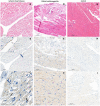Myocardial PD-L1 Expression in Patients With Ischemic and Non-ischemic Heart Failure
- PMID: 35096992
- PMCID: PMC8792535
- DOI: 10.3389/fcvm.2021.759972
Myocardial PD-L1 Expression in Patients With Ischemic and Non-ischemic Heart Failure
Abstract
Objective: Immune checkpoints inhibitors are promising and wide-spread agents in anti-cancer therapy. However, despite their efficacy, these agents could cause cardiotoxicity, a rare but life-threatening event. In addition, there are still no well-described predictive factors for the development of immune-related adverse events and information on high risk groups. According to known experimental studies we hypothesized that cardiovascular diseases may increase myocardial PD-L1 expression, which could be an extra target for Checkpoint inhibitors and a potential basis for complications development. Methods: We studied patterns of myocardial PD-L1 expression in non-cancer-related cardiovascular diseases, particularly ischemic heart disease (n = 12) and dilated cardiomyopathy (n = 7), compared to patients without known cardiovascular diseases (n = 10) using mouse monoclonal anti-PD-L1 antibody (clone 22C3, 1:50, Dako). Correlation between immunohistochemical data and echocardiographic parameters was assessed. Statistical analyses were performed using R Statistical Software-R studio version 1.3.1093. Results: In the myocardium of cardiac patients, we found membranous, cytoplasmic, and endothelial expression of PD-L1 compared to control group. In samples from patients with a history of myocardial infarction, PD-L1 membrane and endothelial expression was more prominent and frequent, and cytoplasmic and intercalated discs staining was more localized. In contrast, samples from patients with dilated cardiomyopathy displayed very faint endothelial staining, negative membrane staining, and more diffuse PD-L1 expression in the cytoplasm and intercalated discs. In samples from the non-cardiac patients, no convincing PD-L1 expression was observed. Moreover, we discovered a significant negative correlation between PD-L1 expression level and left ventricular ejection fraction and a positive correlation between PD-L1 expression level and left ventricular end-diastolic volume. Conclusions: The present findings lay the groundwork for future experimental and clinical studies of the role of the PD-1/PD-L1 pathway in cardiovascular diseases. Further studies are required to find patients at potentially high risk of cardiovascular adverse events associated with immune checkpoint inhibitors therapy.
Keywords: PD-L1; cardio-oncology; cardiotoxicity; checkpoint; dilated cardiomyopathy; ischemic heart disease; myocardial infarction.
Copyright © 2022 Kushnareva, Kushnarev, Artemyeva, Mitrofanova and Moiseeva.
Conflict of interest statement
The authors declare that the research was conducted in the absence of any commercial or financial relationships that could be construed as a potential conflict of interest.
Figures



References
-
- Taube JM, Anders RA, Young GD, Xu H, Sharma R, McMiller TL, et al. . Colocalization of inflammatory response with B7-H1 expression in human melanocytic lesions supports an adaptive resistance mechanism of immune escape. Sci Transl Med. (2012) 4:1–22. 10.1126/scitranslmed.3003689 - DOI - PMC - PubMed
-
- Mok TSK, Wu YL, Kudaba I, Kowalski DM, Cho BC, Turna HZ, et al. . Pembrolizumab versus chemotherapy for previously untreated, PD-L1-expressing, locally advanced or metastatic non-small-cell lung cancer (KEYNOTE-042): a randomised, open-label, controlled, phase 3 trial. Lancet. (2019) 393:1819–30. 10.1016/S0140-6736(18)32409-7 - DOI - PubMed
-
- Borghaei H, Gettinger S, Vokes EE, Chow LQM, Burgio MA, Carpeno JdC, et al. . Five-year outcomes from the randomized, phase III trials checkmate 017 and 057: nivolumab versus docetaxel in previously treated non–small-cell lung cancer. J Clin Oncol. (2021) 39:723–33. 10.1200/JCO.20.01605 - DOI - PMC - PubMed
LinkOut - more resources
Full Text Sources
Research Materials

